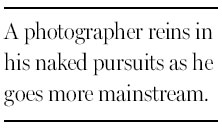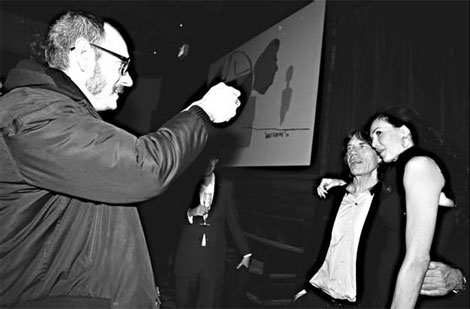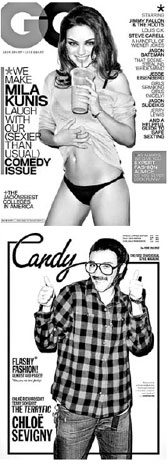The naughty knave of fashion's court
Updated: 2012-03-18 07:59
By Laura M. Holson(The New York Times)
|
|||||||
|
Some stars enjoy Terry Richardson's naughtiness. He shoots Mick Jagger and L'Wren Scott. Emily Berl for The New York Times |
Terry Richardson has become known for a kind of glossed-up 1970s porn chic that is popular in high fashion. In the past 25 years, the photographer has been hired by Gucci, Miu Miu, Jimmy Choo, French Vogue and T: The New York Times Style Magazine, and has chronicled his sexual escapades in lavish photography books. He revels in making viewers squirm while his subjects, often naked or nearly so, wink at the camera.
"That's why we like him," said the actress Chloe Sevigny, who has known him since 1995.
In recent years, Mr. Richardson, 46, has gone mainstream, a celebrity portraitist who recently photographed Gwyneth Paltrow in a thigh-revealing Anthony Vaccarello dress for Harper's Bazaar and the model Bar Refaeli straddling Ronnie Ortiz-Magro, a star of the MTV hit show "Jersey Shore," for Interview. He did ad campaigns for Levi's and Nike.
|
Terry Richardson's photos include Mila Kunis, top, in GQ, and Chloe Sevigny impersonating the photographer in Candy. |
And since February 24, the Ohwow gallery in West Hollywood has shown an exhibit devoted to Mr. Richardson featuring landscapes "that look good on a wall," as he put it. Even the photos Mr. Richardson took while trailing Lady Gaga for a year for her self-titled coffee table book were tame enough to be peddled to the masses.
Mr. Richardson is more in demand than ever, and that means he has more at stake. "He is protective of the character," said Fabien Baron, the creative director who has worked with him for more than a decade. "That is his business now."
Perhaps this is why he seems to be tempering his bad-boy image, distancing himself from the lothario persona he adopted early in his career. When Rie Rasmussen, a model and film director, told The New York Post in 2010 that she found Mr. Richardson's images "degrading," that wasn't good for business. Nor when the supermodel Coco Rocha told Fashion magazine that she did not feel comfortable working with Mr. Richardson and wouldn't do it again.
"Yes, I was upset," Mr. Richardson said. "It's not nice for all these people to make up stuff about you. The flip side is, I just stopped reading it and I kept working."
Mr. Richardson said that in 1991 he moved to New York, where he recorded the underground nightlife of the downtown scene with a Ricoh point-and-shoot camera, finding work at magazines like Vibe and for the Italian designer Sisley.
In 2003, Dian Hanson, a friend and editor at the art book publisher Taschen, was in her Los Angeles office and found boxes containing photographs taken by Mr. Richardson. They had been left by the wife of the company's founder, who had talked to him about a book, but passed. Many of them showed Mr. Richardson having sex with young women, as well as graphic images of women's genitalia, which were later included in the book "Kibosh."
"I was single and I was going to explore sexuality," Mr. Richardson said of the photographs.
In 2004 Taschen released "Terryworld," which, like "Kibosh," was sexually graphic. In it, Mr. Richardson told Ms. Hanson he never asked a model to do anything that he wouldn't do. He also said then, "Getting naked and running around, or having sex in front of a bunch of people, is such a rush."
Mr. Richardson is revered among magazine editors and corporate clients because he is fast and delivers distinctive, buzz-generating shots. When Michael Jackson died suddenly on June 25, 2009, Glenda Bailey, the editor of Harper's Bazaar, said Mr. Richardson was given three days to shoot the English model Agyness Deyn in clothes inspired by the King of Pop.
"The photographs," she said, "had a real sense of vitality."

Strangers often approach the photographer on the street, thumbs up, madly grinning, imitating Mr. Richardson's signature gesture. "Now, it's branded," Mr. Richardson said.
But for many people it is hard to define where Mr. Richardson the brand ends and the man begins. "I think it has to do with Terry's personal style of work," said Doug Lloyd, a creative director and longtime friend. "He blurs the lines."
Indeed, in Mr. Richardson's view, there is little difference.
"I think all your work is personal," he said. "It's your life."
The New York Times
(China Daily 03/18/2012 page10)

